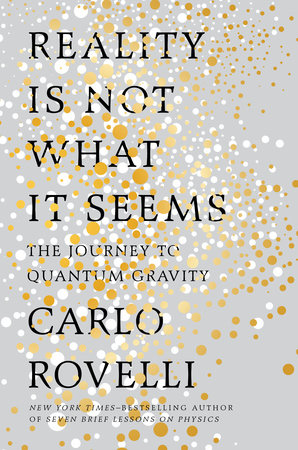Carlo Rovelli - Reality is not what it seems
Carlo Rovelli 2017. Reality is not what it seems. The journey to quantum gravity. Translated by Simon Carnell and Erica Segre. London: Penguin Random House, 255 pp.

So far as I can tell, as of 2017 there are 2 main and competing attempts to create a single explanatory model of the universe and of reality. Any such model must account for the two currently accepted but seemingly incompatible theories, general relativity and quantum mechanics. (Incompatible because, for example, quantum mechanics does not account for the curvature of spacetime.) One of those research fields seeking a unified theory of everything is string theory, which is attempting to create a valid model of the universe comprising 11 dimensions. This book is a guide to the other major research effort: loop quantum gravity, written by one of the physicists responsible for founding this body of work. Although string theory doesn’t get much of a mention (that would be a book with a different title) the content is otherwise wide-ranging and starts at the beginning, 450 BC in ancient Greece.
The layout of the book is like the prose, simple and logical.
Part 1 comprises the first third of the book, and describes the path to what we learned up to the early 1900s when relativity and quantum mechanics revolutionised physics. This fabulous, lucid summary presents 2000 years of scientific progress as largely the result of just a handful of key thinkers: the pre-Socratics especially Anaximander and Democritus (space is finite but boundless, atoms are indivisible); Plato and Pythagoras (mathematics is the key to understanding the universe); Copernicus and Galileo (observe, experiment, interpret); Newton (the laws that prevail on Earth are those that dictate and predict the behaviour of the stars and planets); Faraday and Maxwell (matter as particles and fields).
Part 2 is about that quantum revolution wrought by Albert Einstein and those who developed his theories. Einstein’s special relativity (1905) takes Newton’s Cartesian space in which masses interact over time and replaces it with spacetime. General relativity (1915) goes further: Faraday and Maxwell’s theory of matter represented as particles and electromagnetic fields is joined so that there is now a single field, spacetime, and particles. Subsequent major developments are led by key contributors including the mathematicians Gauss and Reiman, Bohr, Planck, Heisenberg and of course Paul Dirac and Richard Feynman. Carlo Rovelli summarises the main features of the resulting theory of quantum mechanics as being granularity (information in a system is finite and determined by Planck’s constant), indeterminacy (the past does not determine the future, summed statistical probabilities notwithstanding) and relationality (all events interact).
Part 3 and part 4 comprise the last third of the book and describe the essentials of loop quantum gravity, and the implications of that theory. Besides Carlo Rovelli, Lee Smolin and Martin Bojowald have also been key contibutors. I am not game to summarise Rovelli’s already concise account which somehow omits the mathematics while still showing how vital it is. In loop quantum gravity spacetime is granular, comprised of quantised (indivisible) units. The quantum fields of loop quantum gravity do not occur within space, they comprise space. I think. Better re-read this. Regularly. There are some possible consequences:
- Infinity disappears. Space is quantised and finite but boundless - Democritus got there 2600 years earlier.
- Thermodynamics can be reformulated in terms of information theory.
- Time disappears. Time is unnecessary for the physics of loop quantum gravity. Time is just the emergent property of entropy. “The march of time” is just us and our universe cooling down. Therefore time is information we don’t have - the loss of information is another way of saying the increase of entropy.
Quantum gravity theory, like string theory, is just starting to be tested. Observations that tend to support quantum gravity include the failure (so far) of the Large Hadron Collider to observe supersymmetric particles (predicted by string theory). Also, fluctuations in the cosmic background radiation may prove to better support the predictions of quantised spacetime but this mathematics is not yet developed. Unsurprisingly.
(I can’t help but wonder if the quantised spacetime of quantum gravity is a more plausible operating system than the 11 dimensions of string theory: which would we expect to observe if we were living in a simulation?)
The annotated bibliography is also notable: only 4 pages in which books by or about Aristotle, Democritus, Dirac, Einstein, Feynman, Heisenberg, Newton and Plato appear in ones and twos alongside 7 references by Carlo Rovelli himself. Got to like that!
Carlo Rovelli also has a shorter account of quantum gravity in Physics World November 2003 and the references at the end of the Wikipedia page are extensive.
Among the compelling reasons to return regularly to this book are the memorable aphorisms which Carlo Rovelli arrives at in telling fashion. Such as
This permanent doubt, the deep source of science.


